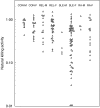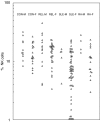Natural killer cell activity in families of patients with systemic lupus erythematosus: demonstration of a killing defect in patients
- PMID: 15958083
- PMCID: PMC1809425
- DOI: 10.1111/j.1365-2249.2005.02822.x
Natural killer cell activity in families of patients with systemic lupus erythematosus: demonstration of a killing defect in patients
Abstract
Natural killer (NK) cell cytotoxic activity and cell frequency, expressed as a percentage of total lymphocytes, have been determined in peripheral blood mononuclear cells from first-degree relatives of patients with systemic lupus erythematosus (SLE), the patients themselves, a group of rheumatoid arthritis (RA) patients and controls. Low levels of killing activity relative to controls were found in some members of all groups with the extent of depression falling into two ranges. Moderate reductions were seen in female (3/31, 10%) and male (4/14, 29%) relatives of SLE patients, female (12/60, 20%) and male (3/4, 75%) SLE patients and female RA patients (6/17, 35%). A more profound depression of killing activity was confined to other female SLE patients (15/60, 25%). There were strong correlations in all groups between killing activity and percentage of NK cells, but analysis of the ratio of these parameters and studies with purified preparations of NK cells suggest that the reduced activity in SLE frequently involves a defect in the killing capacity of the individual cells in addition to the reduced levels of NK cells. Azathioprine (AZA), which was used in treatment of 12 SLE patients, was invariably associated with low values of killing activity. It appears to substantially reduce the percentage of NK and B cells in an action unconnected with the NK cell abnormalities associated with SLE. The finding of low killing activity in relatives and a correlation between their activity and that of their patients support the view that NK cell deficiency is a genetic determinant of SLE. NK cells in SLE may produce insufficient levels of cytokines required for the regulation of IgG production.
Figures





Similar articles
-
Natural killer T cells in families of patients with systemic lupus erythematosus: their possible role in regulation of IGG production.Arthritis Rheum. 2007 Jan;56(1):303-10. doi: 10.1002/art.22326. Arthritis Rheum. 2007. PMID: 17195234
-
Defective natural killer (NK) and killer (K) cell function in systemic lupus erythematosus.J Clin Lab Immunol. 1983 Feb;10(2):71-6. J Clin Lab Immunol. 1983. PMID: 6842577
-
A killing defect of natural killer cells as an underlying immunologic abnormality in childhood systemic lupus erythematosus.J Rheumatol. 1996 Jan;23(1):171-7. J Rheumatol. 1996. PMID: 8838528
-
Natural killer cells in connective tissue disorders.Clin Rheum Dis. 1985 Dec;11(3):507-21. Clin Rheum Dis. 1985. PMID: 3907953 Review.
-
Immunologic and clinical effects of cytotoxic drugs used in the treatment of rheumatoid arthritis and systemic lupus erythematosus.Concepts Immunopathol. 1989;7:20-78. Concepts Immunopathol. 1989. PMID: 2676180 Review. No abstract available.
Cited by
-
Assay of T- and NK-cell subsets and the expression of NKG2A and NKG2D in patients with new-onset systemic lupus erythematosus.Clin Rheumatol. 2010 Mar;29(3):315-23. doi: 10.1007/s10067-009-1322-9. Epub 2009 Dec 10. Clin Rheumatol. 2010. PMID: 20012119
-
NK cell autoreactivity and autoimmune diseases.Front Immunol. 2014 Feb 4;5:27. doi: 10.3389/fimmu.2014.00027. eCollection 2014. Front Immunol. 2014. PMID: 24550913 Free PMC article. Review.
-
Dynamic changes in the numbers of different subsets of peripheral blood NK cells in patients with systemic lupus erythematosus following classic therapy.Clin Rheumatol. 2014 Nov;33(11):1603-10. doi: 10.1007/s10067-014-2712-1. Epub 2014 Jul 15. Clin Rheumatol. 2014. PMID: 25024095
-
The immunological personality of close relatives of SLE patients.Lupus. 2017 Dec;26(14):1513-1516. doi: 10.1177/0961203317707826. Epub 2017 May 23. Lupus. 2017. PMID: 28534426 Free PMC article.
-
Whole-genome bisulfite sequencing identified the key role of the Src family tyrosine kinases and related genes in systemic lupus erythematosus.Genes Genomics. 2023 Sep;45(9):1187-1196. doi: 10.1007/s13258-023-01407-4. Epub 2023 Jun 10. Genes Genomics. 2023. PMID: 37300789
References
-
- Erkeller-Yuksel F, Hulstaart F, Hannet I, Isenberg D, Lydyard P. Lymphocyte subsets in a large cohort of patients with systemic lupus erythematosus. Lupus. 1993;2:227–31. - PubMed
-
- Yabuhara A, Yang FC, Nakazawa T, et al. A killing defect of natural killer cells as an underlying immunologic abnormality in childhood systemic lupus erythematosus. J Rheumatol. 1996;23:171–7. - PubMed
-
- Ewan PW, Barrett HM, Pusey CD. Defective natural killer (NK) and killer (K) cell function in systemic lupus erythematosus. J Clin Lab Immunol. 1983;10:71–6. - PubMed
-
- Blaszczyk M, Majewski S, Wasik M, Chorzelski T, Jablonska S. Natural killer cell activity of peripheral blood mononuclear cells from patients with various forms of lupus erythematosus. Br J Dermatol. 1987;117:709–14. - PubMed
-
- Combe B, Pope R, Darnell B, Talal N. Modulation of natural killer cell activity in the rheumatoid joint and peripheral blood. Scand J Immunol. 1984;20:551–8. - PubMed
Publication types
MeSH terms
Substances
LinkOut - more resources
Full Text Sources
Medical

